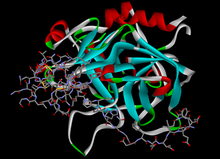| Hirudin | |||||||||
|---|---|---|---|---|---|---|---|---|---|
 | |||||||||
| Identifiers | |||||||||
| Symbol | Hirudin | ||||||||
| Pfam | PF00713 | ||||||||
| InterPro | IPR000429 | ||||||||
| SCOP2 | 4htc / SCOPe / SUPFAM | ||||||||
| |||||||||
Hirudin is a naturally occurring peptide in the salivary glands of blood-sucking leeches (such as Hirudo medicinalis) that has a blood anticoagulant property.[2] This is essential for the leeches' habit of feeding on blood, since it keeps a host's blood flowing after the worm's initial puncture of the skin.
Hirudin (MEROPS I14.001) belongs to a superfamily (MEROPS IM) of protease inhibitors that also includes haemadin (MEROPS I14.002) and antistasin (MEROPS I15).[3][4]
- ^ PDB: 4HTC
- ^ "IV. On the action of a secretion obtained from the medicinal leech on the coagulation of the blood". Proceedings of the Royal Society of London. 36 (228–231): 478–487. 1883. doi:10.1098/rspl.1883.0135.
- ^ "InterPro". www.ebi.ac.uk.
- ^ "Clan IM". MEROPS - the Peptidase Database.